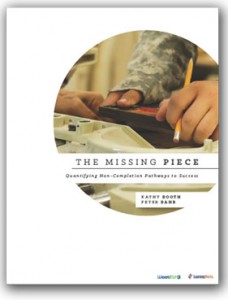THE MISSING PIECE: Quantifying Non-Completion Pathways to Success
Nov 11th, 2013
” . . . in the California Community College system . . . nearly one-third of students took an average of just two courses over about two years and overwhelmingly succeeded in these courses, but rarely attained a degree, certificate, or transferred to a four-year college.”THE MISSING PIECE:
Quantifying Non-Completion Pathways to Success
Community college students increase earnings of up to 15% after taking just a handful of courses in workforce-related fields, such as water and wastewater technology, criminal justice, electronics, information technology, and manufacturing, according to a study by University of Michigan Associate Professor Peter Riley Bahr. The findings point to the importance of employment outcomes in addition to degree attainment in measuring the success of community colleges. Fully 1 in 7 first-time California community college students enroll in six or fewer credits per semester, succeed in those courses at a very high rate, but do not attain a community college credential or transfer to a four-year institution. LearningWorks has published a brief on the new research entitled The Missing Piece: Quantifying Non-Completion Pathways to Success. The brief, written by Bahr and WestEd Senior Research Associate Kathy Booth, examines students opting to build a few skills rather than complete a degree or certificate.
With budgets tight, policy makers and colleges have to make difficult choices about educational priorities. If degree attainment is the primary metric of success, pathways that lead to workforce-related successes may be de-prioritized because they tend to produce lower graduation rates. However, career and technical education programs are vital to rebuilding and sustaining the economy and helping people secure a better wage. Examining skills-builder opportunities and better measuring employment outcomes will help states quickly get skilled workers back into the workplace, support students in choosing the right level of education to meet their goals, and encourage colleges to develop workforce-related programs that better connect students to jobs.
As more states seek to link funding to student outcomes, colleges need ways to measure and evaluate employment-related gains. For skills-builder students, these may include the following.
- External credentials, such as industry certifications and state licenses, which may hold greater value in the workplace than a community college credential
- Improvements to working conditions, such as finding a job in their field of study or transitioning from part-time to full-time work
- Job retention that is dependent on periodic recertification in specific skills or bodies of knowledge
- Earnings gains that clarify how much earnings increased relative to wages before college and whether these increases help students secure a family-sustaining wage
Click here to download the full report.
Click here to download the executive summary.

